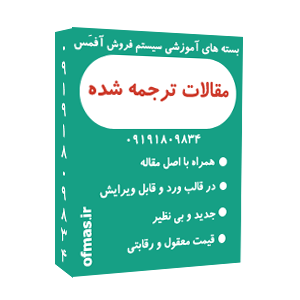ترجمه مقاله اثر مقاومت الکتریکی بر نفوذ جوش نقطه ای در فولادهای زنگ نزن با استحکام بالا در 14 صفحه ورد قابل ویرایش با فرمت doc به همراه اصل مقاله انگلیسی
| عنوان انگلیسی مقاله | Effect of Electrical Resistance on Penetration of Spot Welding in High Strength Stainless Steels |
| عنوان فارسی مقاله | اثر مقاومت الکتریکی بر نفوذ جوش نقطه ای در فولادهای زنگ نزن با استحکام بالا |
| تعداد صفحات و فرمت | 14 صفحه ورد قابل ویرایش با فرمت doc |
| شناسه ثبت محصول | ss23 |
| سطح ترجمه | عالی |
| لینک دانلود اصل مقاله انگلیسی | http://ofmas.ir/tarjome/ss23.pdf |
| دانلود فایل ترجمه | بلافاصله پس از پرداخت آنلاین 18900 تومان قادر به دانلود فایل خواهید و یک نسخه لینک دانلود نیز برای شما ایمیل می شود . |
بخشی از ترجمه :
چکیده
پدیده نفوذ ناگتها در جوش نقطهای فولادهای زنگنزن با استحکام بالا برای واگنهای قطار مسافری بررسی شده است. نتایج حاصله بهشرح زیرند:
1- جریان جوشکاری ( ) مورد نیاز برای ناگتی با قطر mm 4 با افزایش نازککاری نورد سرد صفحات کاهش مییابد.
2- برای موادی که نازککاری نورد سرد متفاوتی دارند، جریان جوشکاری مورد نیاز برای تولید ناگتهایی با اندازه یکسان متفاوت است ولی گرمای مقاومت الکتریکی مورد نیاز یکسان است.
3- برای موادی که نازککاری نورد سرد بالا و جریان جوشکاری پایین دارند، افزایش مقاومت الکتریکی در طول زمان جوشکاری گرمای مقاومت الکتریکی را جبران میکند.
4- مقاومت تماسی ورق - ورق به گرمای مقاومت الکتریکی کمک نمیکند و مقاومت تماسی الکترود - ورق به نازککاری نورد سرد بستگی ندارد.
5- مقاومت رسانا و مقاومت پخش به مقاومت ویژه ماده بستگی دارند. مقاومت ویژه با افزایش نازککاری نورد سرد افزایش مییابد. کاهش جریان جوشکاری با افزایش نازککاری نورد سرد بهدلیل افزایش مقاومت رسانا و پخش است. افزایش مقاومت رسانا و پخش با افزایش مقاومت ویژه، گرمای مقاومت الکتریکی را جبران میکند.
6- افزایش مقاومت ویژه با افزایش نازککاری نورد سرد به مقدار مارتنسیت تغییرشکل - القایی بستگی دارد.
Abstract
Penetration phenomena of nuggets in resistance spot welding of high strength stainless steels for railway passenger cars has been investigated. The results obtained were as follows:
(1) Welding current (I4,o) required to produce a nugget of 4 mm in diameter decreasedw ith increasing cold-rolling reduction of plates.
(2) For materials which had differentc old-rolling reductions, welding currents (I4.0) required to produce the same size of nugget were different, but the electrical resistance heats required were equal.
(3) For material which had a high cold-rolling reduction and a low welding current (14,0), the increase of electrical resistance during welding time compensatede lectrical resistance heat.
(4) The sheet to sheet contactr esistance did not contribute to electrical resistance heat and the electrode to sheet contact resistance did not depend on cold-rolling reduction.
(5) The conductor resistance and the spreading resistance depended on the specific resistance of material. The specific resistance increased with increasing the cold-rolling reduction. The decrease of welding current (14,0) with increasing the cold-rolling reduction was due to the increase of the conductor resistance and the spreading resistance. The increase of the conductor resistance and the spreading resistance with in- creasing the specific resistance compensatedt he electrical resistance heat.
(6) The increase of specific resistance with increasing the cold-rolling reduction depended on the amount of deformation-inducedm artensite.

 دسته :
دسته :